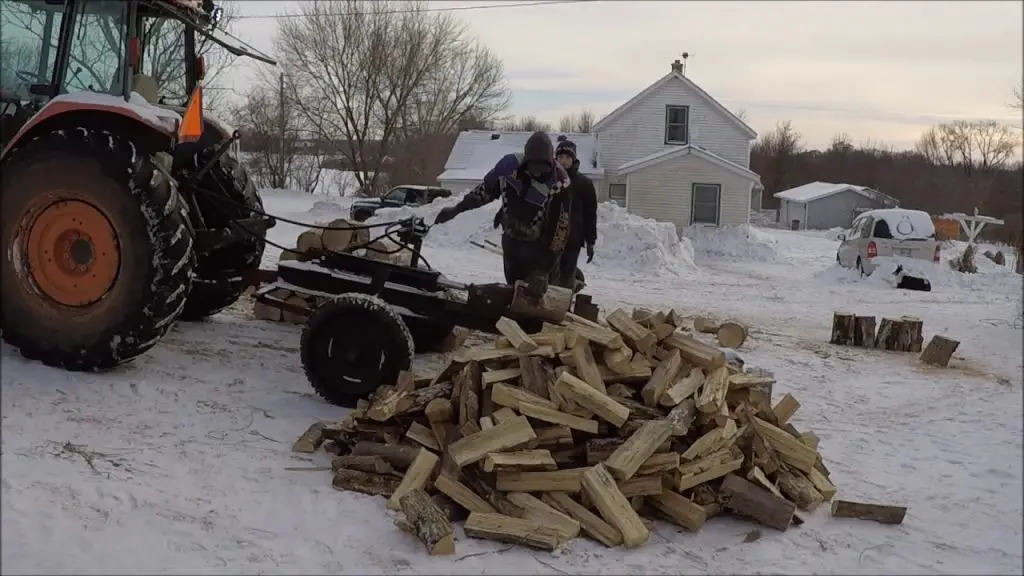To store firewood outside in winter, stack it on a raised platform or pallets to avoid ground moisture, cover the top with a tarp to shield from snow and rain, and leave the sides exposed for air circulation. This prevents rot and promotes drying, ensuring optimal burning efficiency.
Winters are cozier if you have a crackling fire in the fireplace or a stove. The warm and glowing heat is much less expensive than almost all of the gas or electric furnaces you can find on the market. But wood rots and decays, and therefore you need to know how to store firewood outside in winter.
Most importantly, how you stack and store firewood determines its life and service. That is to say, if the wood is not stored correctly, there will be a series of unfortunate events. For instance, higher moisture levels cause the wood to burn improperly, followed by fungus and mold.
I personally recommend this General Tools Moisture Meter. It allows you to accurately gauge how wet your firewood is and whether it is sufficiently seasoned. Over time you can also see how quickly the moisture is dropping and how much longer you need to keep your firewood dropping until it is seasoned and ready to burn.
Press the sharp pins into the wood and you will quickly see the readout show the moisture ranging from 5% to 50%. It also has a Low/Mid/High indication depending on whether the wood is dry enough, so you don’t need to remember the actual values.

Therefore, keeping your firewood safe, dry, and clean as possible should be your top priority if you want to make the most out of your fuel.
Table of Contents
What Happens if Firewood is Not Stored Correctly?
Storage does not mean tossing the firewood in a shed or the garage. Poor storage will always lead to a loss.
Whether you have little or a lot of firewood on hand, it will be rendered useless from poor storage. In other words, firewood can become a house to snakes, rodents, and insects. Yes, termites won’t be the only problem.
Poor storage will also lead to damp firewood, which will result in more smoke than fire and decrease the efficiency of your wood stove. In addition, rotting and decaying firewood can lead to unpleasant smells.

Best Ways to Store Firewood Outside in Winters
Firewood is a great and cheap alternative to gas and fuel. However, just as you need to contain those fuels, the right equipment and space to store and care for the firewood are essential. To help you choose the storage location wisely, here is a list of the best ways for firewood storage outside in winter.
Woodshed
Air circulation is crucial for keeping the firewood dry and seasoned. Therefore, the first and most ideal place would be an open-ended woodshed. However, ensure that the firewood is stacked well off the ground. You need to consider how much firewood you need to store.
Log Rack
Log Rack is a simple and safe way to store firewood. Whether homemade or bought from a shop, keep the rack a few inches off the ground. The reason is to prevent insects and moisture from crawling in.
Furthermore, the log rack should be more than 30 feet away from the house. Firewood is prone to attract insects and pests. Therefore, all the better to keep your home safe from such crawlers.
Fireplace Log Rack
You might feel tempted to keep the firewood inside your home. This option is most suitable for that purpose. But, be sure to thoroughly inspect the firewood for insects before you bring it in. In addition, do not stack large amounts as you might put your house in a vulnerable state because of the termites it may attract.
Whichever option you go with, remember to choose a location that has ease of access. That is to say, how far do you want to go to get your stored firewood?
5 Tips and Ideas on Storing Firewood
Once you have decided on the storage method to go with, here is a list of tips and ideas on storing firewood for longer periods.
- Never try to spray insecticide on the firewood. It may seem like an easier way to prevent insects but once you burn the firewood, the fumes can be harmful to your lungs.
- If the firewood is to be stored inside the house on a fireplace log rack, only then treat the floor with insecticide. In addition, take extra care in case you have children or pets.
- Do not stack firewood against the side of your house. To clarify, this will create a possibility of permanently damaging your siding or wall, either staining or rotting.
- Old comes first. Better to use the old firewood from last winter and place it on top of the new one as it will have higher chances of decay. Therefore, the sooner you use it the better.
- Always check that the chimney and wood stove are clean before burning the firewood. Improper chimneys and stoves that are not in working condition can cause house fires.
Above all, keep the firewood clean. Never treat it with insecticides, solvents, or chemicals. Other than releasing harmful fumes, they increase the combustibility which can lead to uncontrolled fires.
The ideal way is to keep the firewood uncovered which helps with air circulation. However, if it is snowing or raining, the firewood can quickly dampen and lose combustibility. In such cases, a good cover should keep the firewood safe. Most importantly, remember to keep the sides open for air circulation.
The Right Tool for Chopping Firewood
There is only one thing that feels better than sitting by the fireplace after a long day and that is knowing for a fact that you chopped those perfectly round logs.
Although it may seem like a simple yet brute practice, you must use the right tools for chopping firewood. That is to say, a lightweight splitting maul may bounce around while a heavy one may exert more energy than required.
Therefore, choosing the right splitting maul is essential. A good splitting maul will provide splinter-free, fine pieces of firewood that are ready to be stocked and used. When getting yourself a nice splitting maul, pick the length you are comfortable with and head material that will offer a long service life.
Conclusion
Winters are cozy and can be cozier if you are well-prepared. It is better to plan and get the right equipment in time. That is to say, hacking away with a lightweight axe that bounces more than slicing is not very productive.
You can go on about storing the firewood in a woodshed or a log rack. However, when using log racks, there is always a chance of logs rolling down or at the time of burning. In addition, the firewood can be difficult to combust if cut improperly. Never settle for less and prioritize using only the best splitting maul to cut and stack your firewood.
